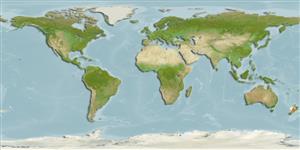Lớp cá viên khẩu (Myxini) (hagfishes) >
Myxiniformes (Hagfishes) >
Myxinidae (Hagfishes) > Eptatretinae
Etymology: Eptatretus: hepta (Gr.), seven; tretos (Gr.), perforated (i.e., with holes), referring to seven gill apertures on what would later be described as Homea banksii (=E. cirrhatus) [range within genus is 6-14 pairs of gill apertures]. (See ETYFish); cryptus: From kryptos (Gr.), hidden or secret, referring to its similar morphology to E. cirrhatus, with which it has been confused in the past. (See ETYFish).
Environment: milieu / climate zone / depth range / distribution range
Sinh thái học
Biển Tầng đáy biển sâu; Mức độ sâu 96 - 922 m (Ref. 115309). Deep-water
Western Pacific: New Zealand.
Bộ gần gũi / Khối lượng (Trọng lượng) / Age
Maturity: Lm ? range ? - ? cm
Max length : 93.1 cm TL con đực/không giới tính; (Ref. 115309)
Short description
Hình thái học | Sinh trắc học
Các tia vây lưng cứng (tổng cộng): 0; Các vây lưng mềm (tổng cộng): 0; Tia cứng vây hậu môn 0; Tia mềm vây hậu môn: 0. Diagnosis: characterized by the combination of the following characters: 7 pairs of gill pouches, 3/3 multicusps, 12–15 prebranchial slime pores (modally 14), 78–86 total slime pores, slime pores without narrow white rim, preocular length 4.8–5.8% TL, and body colour brown to dark brown; differs from all other congeners except E. caribbeaus, E. menezesi, E. strahani, E. cirrhatus, and E. goliath by having 7 pairs of gill pouches and 3/3 multicusps; Eptatretus caribbeaus, E. menezesi, and E. strahani are not found in New Zealand; differs from E. caribbeaus by the number of anterior unicusps (10–11 versus 11–13), posterior unicusps (8–10 versus 10–11), and body colour (brown to dark brown versus light tan); differs from E. menezesi by the tail slime pores (11–14 versus 14–18), total slime pores (78–86 versus 86–94), and ventral finfold colour (brown versus whitish margin); it differs from E. strahani by having visible (versus absent) eyespots, rounded (versus slit-like) 1st few branchial apertures, vestigial (versus welldeveloped) ventral finfold (0.17–0.64%TL versus 1.12–1.16%TL), rounded (versus angled) ventral caudal fin profile, and shallower tail depth (8.1–10.6%TL versus 10.9–12.7%TL); differentiation from E. cirrhatus by the prebranchial slime pores (12–15, modally 14 versus 15– 18, modally 16), its more robust appearance (body depth 8.9–12.0% TL versus 5.9–11.2% TL, often <8.6% TL), and body colour (brown to dark brown versus dark brown to purple-brown); some, and often most, slime pores of E. cirrhatus have a narrow white rim, whereas slime pores in E. cryptus sp. nov. are the same colour as the rest of the body; care must be taken not to interpret residual slime or internal structure of the slime pore for the presence of a white rim; Eptatretus cryptus differs from E. goliath by the trunk slime pores (46–54 versus 56–60) and total slime pores (78–86 versus 89–95); the following character can also help in dissociating E. cryptus from E. goliath: preocular length (>4.8 versus 3.7–5.2% TL) and prebranchial length (>20.3 versus 18.3–20.9% TL) (Ref. 115309).
This species is more commonly found deeper than 500 m. Its biology is largely unknown because it has been misidentified as the common hagfish E. cirrhatus; its stable carbon and nitrogen isotope signature indicated that this species feeds at a high trophic level, 3 levels above primary producers (Ref. 115309).
Life cycle and mating behavior
Chín muồi sinh dục | Sự tái sinh sản | Đẻ trứng | Các trứng | Sự sinh sản | Ấu trùng
Zintzen, V., C.D. Roberts, L. Shepherd, A.L. Stewart, C.D. Struther, M.J. Anderson, M. McVeagh, M. Noren and B. Fernholm, 2015. Review and phylogeny of the New Zealand hagfishes (Myxiniformes: Myxinidae), with description of three new species. Zool. J. Linnean Soc. 174:363-393. (Ref. 115309)
IUCN Red List Status (Ref. 130435)
Threat to humans
Harmless
Human uses
Các nghề cá:
Thêm thông tin
Age/SizeSự sinh trưởngLength-weightLength-lengthLength-frequenciesSinh trắc họcHình thái họcẤu trùngSự biến động ấu trùngBổ xungSự phong phúBRUVS
Các tài liệu tham khảoNuôi trồng thủy sảnTổng quan nuôi trồng thủy sảnCác giốngDi truyềnElectrophoresesDi sảnCác bệnhChế biếnNutrientsMass conversion
Các công cụ
Special reports
Download XML
Các nguồn internet
Estimates based on models
Phylogenetic diversity index (Ref.
82804): PD
50 = 0.5000 [Uniqueness, from 0.5 = low to 2.0 = high].
Bayesian length-weight: a=0.00204 (0.00092 - 0.00452), b=2.93 (2.73 - 3.13), in cm total length, based on LWR estimates for this (Sub)family-body shape (Ref.
93245).
Mức dinh dưỡng (Ref.
69278): 4.4 ±0.7 se; based on size and trophs of closest relatives
Fishing Vulnerability (Ref.
59153): High vulnerability (57 of 100).
